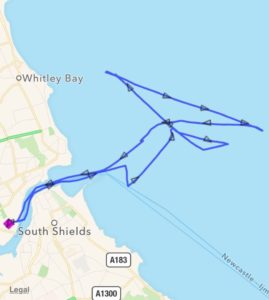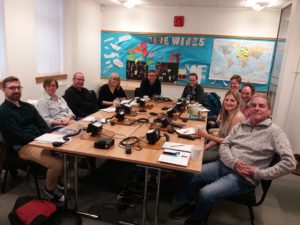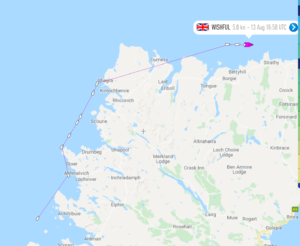 Northumbria Sailing
Northumbria Sailing
The Leading Provider of Sail Cruising Courses in North East England
October Newsletter
‘The sea provides visions, darknesses, revelations’ – Hillaire Belloc, author
Normally at this time of the year I would be reporting the end of practicals until next season. Not so this time, as I have an almost full five day course in October/November and have now arranged another in response to demand. Theory is a little more normal with the autumn Day Skipper now full, but demand has been strong for the winter Yachtmaster and, this week, I start a private Yachtmaster Ocean Course. Practicals have had a great September where we have enjoyed strong westerly winds and exciting sailing conditions.
I feel strongly that we should support local chandleries and boat services and I unashamedly ask my readers to visit Storrar Marine, who are situated just off the Coast Road, Newcastle upon Tyne, opposite Crosslings. Here you can take advantage of a lifetime’s experience and knowledge and they offer 15% discount off clothing. I would also mention PA Lynch of Morpeth. Buying online will result in the disappearance of this type of chandlery and with it will go the advice. In short, you may end up buying the wrong thing online.
 September Successes
September Successes
The latest, but not the final, ‘batch’ of the season and I congratulate, L to R, myself of course, Denis, John, Jim & Donal now in possession of their RYA Day Skipper Practical/Competent Crew certificates. A very entertaining and informative week with good weather, westerly winds with pleasant seas. A marked change from the cold, easterly, winds experienced by Denis during his early April Competent Crew course!.
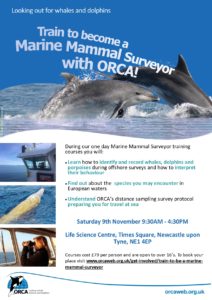 Orca Whale Project
Orca Whale Project
Put this in your diary Saturday 9th November at Newcastle’s Life Centre and you could be a whale spotter. Last year’s RYA Examiner told me he was going with his wife.
Ladies at the Helm
 Karen Hartley second from left, reports; ‘It started with a bit of a bored search on the World Wide Web – sailing courses for ladies …. Fast forward several weeks and I pulled up into a carpark in Hamble with a considerable amount of trepidation. Frequently the only female on board, I am used to there always being someone younger or fitter taller/stronger than me and now I was about to embark on a ladies only sailing course for a week and was wondering if the same would apply.
Karen Hartley second from left, reports; ‘It started with a bit of a bored search on the World Wide Web – sailing courses for ladies …. Fast forward several weeks and I pulled up into a carpark in Hamble with a considerable amount of trepidation. Frequently the only female on board, I am used to there always being someone younger or fitter taller/stronger than me and now I was about to embark on a ladies only sailing course for a week and was wondering if the same would apply.
Having met my three crew mates, I was open minded about whether our skipper was male or female. Our skipper turned out to be a fabulous, calm, unflappable lady, an RYA Offshore Instructor and Examiner and qualified private pilot to boot! I was further reassured as we approached our boat and home for the week to discover that it was a Sigma and very similar to our family boat.
The following morning our skipper soon had us underway and assessing our skills as we made our way out into the Solent for a sail down to Cowes in a brisk westerly wind. Above us a Spitfire from Lee-On-Solent was looping the loop (£2,750 for a 30 minute flight apparently!) as we picked up a mooring buoy for lunch. A sharp gust caught the boat as we hooked the buoy and the hook was wrenched out of our hands. It jammed in the ring and we had several attempts at lassoing the buoy before we succeeded. With the boat moored and the errant hook rescued we were able to enjoy lunch whilst watching the ongoing air display and all the boats coming and going from Cowes. That night we headed to the Beaulieu River, past the pretty New England style lighthouse, onto a mooring by the salt marsh bird sanctuary and a very peaceful night’s sleep was had by all.
Thanks to my Day Skipper theory (which I had done with Northumbria Sailing) I volunteered to hone my skills and be the passage planner for a night sail up Hamble River. It couldn’t be too complicated after all. Off we set, ticking off lights and landmarks as we sailed past them and all was going according to plan. At a bend in the river we were on the lookout for a fixed green light but we just couldn’t see one – there was a flashing green light but that’s not what was marked on the chart so maybe we were in the wrong place? I double checked it as did a crew mate and we both agreed that the chart showed a fixed green light. Meanwhile our crew mate at the helm was asking for direction. I was foxed! The devil on one shoulder said ‘push on – other boats are along here’ and the angel on my other shoulder said ‘hmmm, you can’t just blunder on when you don’t know where you’re going!’ Our skipper broke the impasse and guided us onwards. On checking the chart later, she agreed that it showed a fixed green light, but had known that didn’t sound right because a fixed green light is a navigation light. The moment passed, but I still hadn’t quite got it. Could charts be wrong? On the long drive home to Durham I was mulling over why I hadn’t asked for clarification. I suppose it seemed like one of those questions which was just too stupid to ask. Back on my own boat I pored over charts and my 5011 symbols book but still couldn’t fathom it out. Finally I decided to ask Melvyn and was somewhat reassured that he found it a bit strange too! He checked and concluded that it seems optional whether to show the flashing characteristic and that it will depend on the scale, with large scale giving more space. So, a further complication to add into the passage planning mix!
The week continued with lots of mooring, tacking, controlled gybing, theory, mild panic about spending a third night on a mooring buoy without a shower or internet connection and hugs when encouragement was required. We all agreed that it was with heavy hearts that we made our way around the notorious Bramble Bank and back to Hamble. We had without doubt progressed from a group of strangers into an efficient, supportive team of equals and we had had a great week!
Red Hat Time
Whilst at sea, one of my exercises is to produce a cap with the comment ‘this is my favourite cap and very special to me’. I then proceed to dump it in the water and ask victims to recover using the Man Overboard recovery procedure they have already practised. This was duly done last month but we all agreed a blue cap wasn’t the most visible at sea. A few days later I opened the post to find I had been sent a red cap, which I will now use in future.
 Berwick Pontoon Open
Berwick Pontoon Open
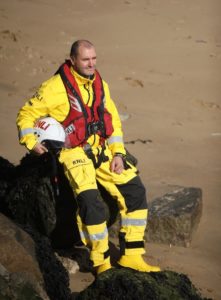 Saving Lives Locally
Saving Lives Locally
Peter Lennox is one of the RNLI’s All Weather and Inshore Lifeboat crew based in Tynemouth, a berth I pass frequently on my way out to sea (and have had call to need them!) In Peter’s daytime job he overlooks the river Tyne and can keep an eye out for me too; ‘I joined because I wanted to be involved with a local cause and, as I love boats and being on the water, I felt drawn to the RNLI as a charity, especially if I could be part of helping someone in difficulty out on the water.
I get a great sense of achievement following a challenging shout (service call out). Shouts can be at any point of the day or night, 365 days of the year. The most challenging being when the pager goes off next to me in the early hours of the morning, the pager loud with a fast-paced beat. Maintaining composure at these times whilst dark and cold outside tests resilience. The most challenging shout recently was attending to a casualty who had fallen from a big height who needed to be evacuated via the shoreline’. Watch out for the RNLI’s ‘Saving Lives at Sea’ on the BBC, it’s riveting viewing watching rescues filmed as they happen.
So when did you last do a proper rig check?
 John Williams is a good source of interesting articles and here’s his latest; ‘Earlier this month four of us, all experienced sailors were taking part in the Fastnet Race which goes from Cowes, around Fastnet rock off SW Ireland and back to the finish at Plymouth some 600 miles later. The yacht was a Class 40, basically a high performance 40’ flat out no frills race boat. Under the Offshore Safety Rules the Fastnet is rated Category 2 which means a significant level of safety fit out and crew training.
John Williams is a good source of interesting articles and here’s his latest; ‘Earlier this month four of us, all experienced sailors were taking part in the Fastnet Race which goes from Cowes, around Fastnet rock off SW Ireland and back to the finish at Plymouth some 600 miles later. The yacht was a Class 40, basically a high performance 40’ flat out no frills race boat. Under the Offshore Safety Rules the Fastnet is rated Category 2 which means a significant level of safety fit out and crew training.
On the evening of the second day we were on a course about 10nm NW of the Scillies, wind 24 kts gusting to 30 kts with 2-3m waves. These conditions are fine for a water ballasted Class 40 and with one reef and a full genoa and we were on a tight reach averaging 13 kts with bursts to 17 kts in the gusts. It had started to get a bit exciting so we put in a second reef and luffed a bit to slow down whilst this was carried out.
Without any warning the deck stepped mast and the whole rig came down over the starboard quarter carrying away most of the guard rails and damaging the coaming but fortunately avoiding hitting anyone in the process.
It was clear that the 60 foot carbon spar, boom and sails was not going back up and in the sea conditions, the mast and broken spreaders hanging over the side was threatening to knock a hole in the boat. The decision was quickly taken to cut the whole thing free and this took about 20 minutes involving a large cutter, an angle grinder (we had rod rigging) or the knocking out of pins.
We self-rescued and did not need to call on any emergency service although it took 22 hours to motor back to Plymouth.
Lessons/Observations:
- We still don’t know why the rig went over the side except that the forestay gave way low down (observed). The possibility of any further forensics unfortunately lies in 92m of water.
- A comprehensive rig check from the very top of the mast to deck level had been carried out 3 weeks earlier.
- Everyone worked calmly and methodically to cut the rig away, tidy up and check and check again for stray ropes before starting the engine.
- Make sure your angle grinder is fully charged. It’s much better than cutters on rod rigging, pins are hard to knock out under load and hacksaws would be an absolute last resort.
- Beware of rod rigging springing back when suddenly released from the weight of a hanging mast and rig.
- As no one was injured and no life was endangered we resisted the immediate temptation to call either a Mayday or Pan Pan
- When the mast comes down you lose the use of items of equipment that we normally take for granted. These include;
- The main VHF aerial (although we had an emergency aerial it was obviously height limited)
- The AIS (both receive and transmit)
- The radar scanner
- Tricolour, steaming and deck lights
- Wind instruments
- Make sure you have enough diesel fuel for this kind of eventuality.
- The motion of the boat like ours with a 3m keel but no rig is at times quite violent, like a cork in a washing machine.
- As we were in a race with a lot of competitors coming up behind on the same course we managed to use the handheld VHF to contact other boats appearing through the very poor viz. to relay to race control and the coastguard that we were all OK and enroute back to Plymouth.
- Crossing a TSS at night with reduced nav. lights, v. poor viz. and no on board AIS is ‘tricky’. I would never normally use a phone based app because of the latency in updating and signal issues but in this case we had no choice and ‘Boat Beacon’ served us fairly well although obviously we did not have a transponder so were not seen by other ships.
- When you finally get ashore break out the single malt and resolve to have another go in 2 years time!
 What Causes Seasickness?
What Causes Seasickness?
Phil Butler linked me into this very useful article. I’m telling everyone that it’s normal to be seasick and also normal to get over it. Only a few are never seasick. Take the tablets though until you are confident you are OK, as they are very effective. Seasickness
 King’s Tall Corner (Episode 1)
King’s Tall Corner (Episode 1)
I am pleased to announce I have acquired the exclusive serialisation rights to Liz King’s adventures of 2019, which will appear over the next few months. This image shows Liz, ?seated, flanked by Michael, left, and Alan.
‘A busy, but rewarding year…
At the end of 2018, on a cold day at Royal Quays Marina, I did one of Melvyn’s RYA Diesel Engine courses – and I can honestly say that I have learned more about boat engines in the intervening twelve months than I ever thought possible! I have sworn at, crawled under, stripped (engines, that is…), nursed, changed and condemned engines, gearboxes and starting motors this summer – and don’t even get me started about the benefits of greased nipples…
My adventures began in March when I sailed the Blyth Tall Ship, Williams II, out of Blyth at the beginning of our Round Britain Expedition. We had a fabulous time and the old girl (the ship, not me) behaved impeccably. Some of her “systems” let her down (mainly her gearbox), but in general she was sound and very forgiving to sail. The dolphins were great, the winds were mainly gentle and the tides (especially in the Pentland Firth) were terrifying (we went through at 11.5 knots, sideways). We completed the circumnavigation in ten weeks and covered 2000 nautical miles. After completing our expedition we took Williams II down to London, where we were one of the major attractions at the Offshore Energy Exhibition at the Excel Centre.
A Kill Cord Could Save Your Life
Always wear one RYA Kill Cord
I hope you enjoy this Newsletter and you can ask me to e-mail it to you monthly
Update on Courses & Trips
‘Keeping your brain active protects against dementia, probably because it increases the quality of your cognitive reserve – the connections within the brain network’
THEORY COURSES
In my day there was a choice between an evening class or correspondence and I actually did my Day Skipper Theory twice. First by correspondence and later by evening class as I wasn’t convinced that I knew the subject as well as I wanted, even though I had passed.
The Local Authority Evening Class had a cost subsidy so was cheap, but a large class, perhaps 20+, and set in school. The large number prevented the instructor from giving personal attention and proceeded at a set pace and it was up to you to keep abreast, or fall away. Over two terms as well, the class seemed to go on forever and was a real struggle to go out on a November evening into a basic, school, setting.
The Local Authority classes seem to have expired leaving, realistically, class, private or online. The RYA is developing a part online Course as an option and some schools provide their own version.
You can now choose which suits you best and factors you may wish to consider are:
1. If you live so far away you will probably only have the online option or a residential Fastrack
2. There are some subjects which, in my opinion, are difficult to learn online. Chartwork principally, but also tides and time zones. I have seen many instances of the correct answer being produced with chartwork, but quite the wrong drawing.
3. Online multi choice, as one victim put it ‘I could see that by clicking an option I would be allowed through, but couldn’t understand why’.
4. Most of my victims haven’t done anything like this for many years and need time to assimilate together with explanation, not just given another paper to try.
5. Learning in company creates friendships, crewing opportunities, and a bit of laughter
6. I have a warm and comfortable room in a modern building in Heaton, Newcastle upon Tyne with unrestricted street car parking at hand
7. One2one is often done at The Lock café, Royal Quays, with excellent surroundings and a latte to hand!
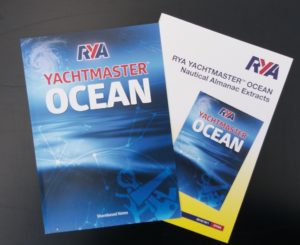 RYA OCEAN YACHTMASTER Explore the wonders of a sextant with Celestial Navigation and Ocean Passage Planning. This ‘top of the range’ RYA theory course can lead to the coveted ‘Ocean Yachtmaster’ ticket. I have four sextants, one new lightweight metal, one plastic & two old brass, for you to handle. A practical session is included. Cost £495 or £725 on tailored tuition. It’s possible to come for the Celestial Navigation only. The US Navy are teaching sailors Celestial Navigation again as a precaution against cyber attack. US Navy.
RYA OCEAN YACHTMASTER Explore the wonders of a sextant with Celestial Navigation and Ocean Passage Planning. This ‘top of the range’ RYA theory course can lead to the coveted ‘Ocean Yachtmaster’ ticket. I have four sextants, one new lightweight metal, one plastic & two old brass, for you to handle. A practical session is included. Cost £495 or £725 on tailored tuition. It’s possible to come for the Celestial Navigation only. The US Navy are teaching sailors Celestial Navigation again as a precaution against cyber attack. US Navy.
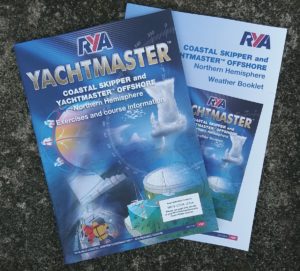 RYA COASTAL YACHTMASTER The advanced Course, a must for those proceeding to Yachtmaster level. Cost £475 for class & £650 tailored tuition. You need a good knowledge of this Course before being tested by the RYA Examiner. Since the Course was re-written by Chris Slade, one of my RYA Inspectors, it’s a lot more challenging, but relevant. Next Course; January 9, 11, 16, 23 & 30th, February 6, 8, 13 & 27th, March 5, 12, 19, 25 & 26th Phil from 2018 says; ‘Although I knew the YM Theory would be a step up and a challenge the hard work and effort was worth it once I got out there on the boat. That extra depth of knowledge really helped me understand the dynamics of sailing, sea conditions, anticipated weather looming on the horizon and, of course, it’s likely impact on boat handling and the crew’.
RYA COASTAL YACHTMASTER The advanced Course, a must for those proceeding to Yachtmaster level. Cost £475 for class & £650 tailored tuition. You need a good knowledge of this Course before being tested by the RYA Examiner. Since the Course was re-written by Chris Slade, one of my RYA Inspectors, it’s a lot more challenging, but relevant. Next Course; January 9, 11, 16, 23 & 30th, February 6, 8, 13 & 27th, March 5, 12, 19, 25 & 26th Phil from 2018 says; ‘Although I knew the YM Theory would be a step up and a challenge the hard work and effort was worth it once I got out there on the boat. That extra depth of knowledge really helped me understand the dynamics of sailing, sea conditions, anticipated weather looming on the horizon and, of course, it’s likely impact on boat handling and the crew’.
RYA DAY SKIPPER A popular starting point for many. Same Course for Sail or Power. This is a Course where early booking is essential. Classes take place in a modern building in Heaton, Newcastle upon Tyne. Included is a half day visit to the School boat. Cost £425. Autumn evening class sessions; September 30th, October 7, 12, 14 & 21st November 4, 11, 18, 23 & 25th December 2 & 9th (FULL) Winter/Spring evening class; January 13, 20, 25 & 27th February 3, 10, 24 & 29th March 2, 9, 16 & 23rd. For Bareboat charter this is the first qualification to be obtained. Nevertheless in some areas, the Solent for example, a higher qualification is needed and UK tidal requested. An example from one web page; ‘RYA Coastal Skipper Tidal Practical course completion certificate must show the course was conducted in UK tidal waters. For example courses conducted in the Gibraltar & the Mediterranean are not accepted as tidal courses. The ICC qualification alone is not an acceptable qualification.’
I can’t do these times and am in a hurry!
Then a Tailored Timetable with one to one tuition could be for you. Costs £625 (£950 a couple) for Day Skipper, £650 for Coastal/Yachtmaster™ and £725 for the Ocean. Available when the diary permits.
Whilst I would not wish to encourage missing sessions, it’s a fact of life in todays world and time can be made up through private sessions or, sometimes, within the class timetable
TIDES In response to demand I’m offering this Course on tides, not RYA Tides, but real UK tides, especially on our North East Coast. Learn how to calculate tidal heights and streams. Join any of the four at £25 each or £90 for all four. Each session takes place 6 – 9pm at Heaton; Session 1 will be Day Skipper level with tides at standard ports. Session 2 will be advanced with secondary ports, Session 3 Tidal streams. Session 4 will go through examples and homework set from previous sessions. Also to be explored are the less common e.g tidal coefficients. Next sessions; Spring 2020
PRACTICAL COURSES
All local courses take place on the school boat, a quality 36 foot Hallberg Rassy, well known for its comfort and steadiness afloat. Properly equipped with modern electronics, the preferred wheel steering and comfortable, recently replaced, bunk cushions you will be well set up to handle whatever may come your way. Courses are fully inclusive, except for a kitty contribution towards drinks onshore.
PRACTICAL CREWING My version of RYA Competent Crew. Three days, 0930-1700hrs onboard for up to four. 4:1 private tuition and you will be up to the Comp Crew standard. No experience necessary and no need to stay onboard overnight. Cost £275, weekday only.
DAY TRIPS. ‘Taster’ days run throughout the season with the aim of having a pleasant day out on the water. You can see whether yachting is for you at modest cost. Trips operate out of Royal Quays 0930 – 1700hrs. Cost £60 weekday & £75 weekend. Yes, describing it as a “taster” is an understatement. It was a practical and thoroughly excellent training day. It’s a credit to your skill and confidence to take two complete novices to sailing at sea out into force 7+ and make it feel so easy. Your training plan and instruction was just right and delivered with clarity and a sense of humour which quickly removed any tension. I know Peter had as much fun as I did and we both came away with a heightened enthusiasm. – David
RYA COMPETENT CREW A 5 day, live aboard, course where you will learn ‘the ropes’ and to become a useful crew member. A good start to, perhaps, a lifetime boating. Cost £595. Course dates; October 24 & 25th+November 5 – 7th (FULL) and October 13 – 18th, April 19 – 24th, May 17 – 22nd. Course Review
RYA DAY SKIPPER PRACTICAL The key to bareboat charter, this course aims to get you to the ability ‘ to skipper a small cruising yacht safely by day in tidal waters with which the student is familiar’. Then you can be let loose to find your own adventures and provide endless anecdotes for you to enjoy telling. (The caption shows the June victims enjoying fish & chips on the final day) Cost £625. Course dates; October 24 & 25th+November 5 – 7th (FULL) and October 13 – 18th, April 19 – 24th, May 17 – 22nd.‘I was pleased with the way the course was organised, the instructions for preparation and attending, the fact that you were there waiting for me when I arrived, and your welcome both before and after we boarded.’ – Hassall. Course Review by Tim Edwards For a murky glimpse of a night sail try Night Sail
RYA COASTAL SKIPPER PRACTICAL The ‘top of the range’ RYA practical course providing greater challenges to get you up to the standard to skipper a cruising yacht safely by day and night. A sample requirement for chartering a yacht on the Clyde; ‘Skippers must hold/be experienced RYA Coastal practical or Yachtmaster practical when sailing within the Clyde. Outwith the Clyde – Yachtmaster practical’. Cost £625 Jonny Colwell gives a detailed review of his YM Examination
RYA START YACHTING A two day course for beginner groups, which can be the ‘start’ of greater things. You live onboard for two days and visit another marina, away from Royal Quays. Cost £230.
INTERNATIONAL CERTIFICATE OF COMPETENCE (ICC) This can be done on the same course as Day Skipper/Competent Crew. Cost £625 with dates as above. Alternatively I can test you on your own boat at much cheaper cost. Individual quotations are given for this which will be from £225 for one day, own boat ICC Guidance
Northumbria Sailing on Video
Have a look at my Theory Training Centre with this video. Training
Onboard the Hallberg Rassy training yacht, by courtesy of Mark Batey and the kind co-operation of victims Andrew and Clive. See me giving berthing advice in trying to avoid the electric supply post Mark Batey Day Training
RYA Competent Crew in the sun, by courtesy of Mark again Mark Batey Competent Crew
Pieces of Eight – Knotty Problems Analysed
How do you enter and leave Royal Quays lock? Negotiating this lock is not easy and berth holders and visitors alike can be treated to a ‘character forming experience’. Unfortunately, this can result in a fear of entering the river and consequential ‘harbour rot’. Courtesy of Phil Butler, I’m shown entering and leaving the lock, made more difficult with the other boat already there. Fortunately this was correctly positioned at the front of the lock and, happily, we entered and left at this busy time on August Bank Holiday Saturday without incident.
Specialist Courses
RYA VHF This important Course is available in class, online or private tuition. Don’t be caught without a proper licence as you could be fined up to £5,000, plus 6 months inside, plus equipment confiscation – yes it’s very severe! At Northumbria Sailing you will receive tuition one per training set. As you will be assessed for practical skills as well as theoretical I think it’s advisable that you have every opportunity to familiarise yourself with the equipment. Cost £115 plus £60 for the RYA. Next Course, a Full Day; 17th October. September yet to be announced. Also available One to One at £180 and online at £85 to include manual. Assessment £60 extra. Try these links. RYA Online VHF Radio and RYA Online VHF video
RYA RADAR Are you safe using your set? Can you properly identify a collision situation? If you have radar you are required to know how to use it properly and could be held responsible if an incident was to occur. Some radar knowledge is now considered essential for Yachtmaster candidates. Day Course: Cost £120, plus 10 to RYA. Next Course; 18th October. ‘Thank you very much for yesterday’s course’ – Stephen
CEVNI test for the Inland waterways endorsement to your ICC. Done online, cost £30
RYA DIESEL ENGINE
A Volvo Penta 2003 marine diesel engine will be used for demonstrations and you will get several chances to try your hand at changing filters etc.
The Course is for beginners and will show the simple maintenance tasks you are can do yourself to help maintain your engine in working order. The RNLI has complained that most of call outs are from engine failure where simple tasks have not been performed. Your rescuing lifeboat may make firm suggestions if this is found to be the case. Cost £120 plus £10 for the RYA Pack. Maximum 6 persons. Next Course; October 8th RYA Diesel Engine
RYA ESSENTIAL NAVIGATION ONLINE Do this starter course on your own laptop. A good introduction to the theory part of sailing, with yacht or power boat. Cost £79 plus £28.50 (includes instruments) for the RYA Pack. Online Navigation
RYA FIRST AID. All day for the RYA certificate, valid three years. Be prepared for a full day’s activity with lots of practical demonstrations and active participation – no going to sleep here with Simon!. To check which certificates are acceptable to the RYA e.g. for examinations First Aid Certificates Cost £75, £95 with Cat C drug endorsement, + £7 RYA Pack. Next Course; 26th February ‘Simon was fantastic yesterday, best First Aid instructor I’ve ever had and, being a fellow sailor, he was able to put things into a sailing context. Being an ex-instructor myself, I was very impressed with him.’ – Phil
 Two Fingers to a Windlass
Two Fingers to a Windlass
Colin Banks witnessed a rather nasty accident whilst sailing in the Med; ‘There was a scary moment this morning as I was chilling in the shade at the marina. I was watching a Greek hand balling his anchor chain in as his windlass was faulty. From there I heard an almighty scream so I ran to his boat to help him as his fingers were crushed into the windlass by the anchor chain. I managed to free him within seconds but his fingers were snapped and crushed. Paramedics came and he was airlifted off. They reckon he will lose at least two fingers. Me and an old hand in the port done our best to put the boat right. In doing so we found that the windlass control was shorting out due to lack of maintenance this resulting in making the windlass of it’s own accord to wind in and out and that’s what happened to the man while manually hand balling. This is an important wake up call to the real every day dangers of working a boat.’ PS ‘The accident isn’t as bad as first anticipated. He got away lightly with one badly broken finger and severe cuts but I reckon his holiday is over.’
From The Archives
Looking back over the years, and it’s now 10 since Northumbria Sailing was underway for the first time, I’m looking back, this time from October 2014;
 Polar Bear on Charter
Polar Bear on Charter
I took the opportunity to charter the 70 foot, round-the-world, yacht for a day out, which was very successful as the image shows.
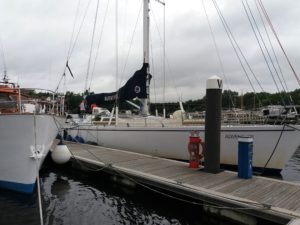 I was reminded of this when Polar Bear, now having been sold, made it’s way into Royal Quays, occupying it’s old berth. Now owned by Joint Services Training and re-named Adventure the yacht was off for the high seas. Not that it wasn’t an adventure back then for crew and myself. The yacht only just goes through the lock and Malcolm has cause to remember the large diameter cordage which damaged his back.
I was reminded of this when Polar Bear, now having been sold, made it’s way into Royal Quays, occupying it’s old berth. Now owned by Joint Services Training and re-named Adventure the yacht was off for the high seas. Not that it wasn’t an adventure back then for crew and myself. The yacht only just goes through the lock and Malcolm has cause to remember the large diameter cordage which damaged his back.
Victims (all) at Sea
Mark Baty experienced a real ferryglide; ‘On holiday in Latvia we came across this hand-operated ferry that works on exactly the principle you teach when mooring up in a river. The ferryman swings the boat so that the current does all the work moving it across the river – there is no external power at all, just a steel cable strung across the river that the ferry is hooked on to. It was a bit nerve-wracking driving our hire car onto it, but probably less so that my early attempts at berthing!’ https://youtu.be/uPe_xXs5mqg
 Rob Langley is making his and the family’s way down to warmer climes; ‘After bringing Pendragon down to Plymouth from the Clyde, we had a good passage cross-Channel and down the western coast of Brittany through the Chenal du Four, a 12 mile channel through rocks and shoals, and round into Brest. Having to use my rusty schoolboy French on the VHF was the scariest part, but Marina du Chateau was very friendly, and the facilities excellent. We spent several weeks family cruising down to La Rochelle. The west coast of France is warmer and sunnier than the Channel, with many lovely islands, walled towns, good marinas and hardly any tide. The Bretons have a great attitude to life, and make some great beer (sampled in a great pub in L’Aberwrach). Coming back round by Ushant into North Brittany the coast became rockier, and the tides really challenging. We used the French “SHOM” tidal atlas, and NRV chart folios for long winding approaches to harbours like Trebuerden and St Malo. Pendragon is now waiting in St Helier for us to bring her back to Royal Quays for her winter berth, but we would strongly recommend the western cost of France as a cruising destination. We’ll be back next year to Quiberon and the Isle de Re’. The image is entitled, ‘Sunset over Douarnenez, south Brittany’
Rob Langley is making his and the family’s way down to warmer climes; ‘After bringing Pendragon down to Plymouth from the Clyde, we had a good passage cross-Channel and down the western coast of Brittany through the Chenal du Four, a 12 mile channel through rocks and shoals, and round into Brest. Having to use my rusty schoolboy French on the VHF was the scariest part, but Marina du Chateau was very friendly, and the facilities excellent. We spent several weeks family cruising down to La Rochelle. The west coast of France is warmer and sunnier than the Channel, with many lovely islands, walled towns, good marinas and hardly any tide. The Bretons have a great attitude to life, and make some great beer (sampled in a great pub in L’Aberwrach). Coming back round by Ushant into North Brittany the coast became rockier, and the tides really challenging. We used the French “SHOM” tidal atlas, and NRV chart folios for long winding approaches to harbours like Trebuerden and St Malo. Pendragon is now waiting in St Helier for us to bring her back to Royal Quays for her winter berth, but we would strongly recommend the western cost of France as a cruising destination. We’ll be back next year to Quiberon and the Isle de Re’. The image is entitled, ‘Sunset over Douarnenez, south Brittany’
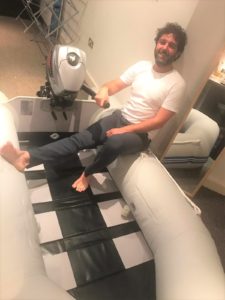 Marcelo has bought a yacht, a Bavaria 37, and I have promised him I will give his boat a wide berth!
Marcelo has bought a yacht, a Bavaria 37, and I have promised him I will give his boat a wide berth!
 John Matthews has also taken, finally, the plunge and has bought a Najad 33 which now rests in Royal Quays on Pontoon E probably awaiting the result of his application to join our select Pontoon F where many victim’s boats reside currently
John Matthews has also taken, finally, the plunge and has bought a Najad 33 which now rests in Royal Quays on Pontoon E probably awaiting the result of his application to join our select Pontoon F where many victim’s boats reside currently
 Emre’s great achievement this year has been to sail around the top. Many seafarers, when talking about sailing around Britain, take the short cut via the Caledonian canal from Fort William to Inverness. Having sailed to Oban from Royal Quays, Emre enjoyed a family sail for a week before the ‘hard seafarers’ joined him in Mallaig. Steve and Jonathan fulfilled such a role and off they sailed north. The AIS image shows an apparent shortcut across land, but there’s not many AIS co-ordinators up there and they did, in fact, round Cape Wrath, ending up in Scrabster’s pub, looking a little tired. Stormbound in Peterhead was an unexpected delay but all arrived safe and (un)sound into The Lock café at Royal Quays.
Emre’s great achievement this year has been to sail around the top. Many seafarers, when talking about sailing around Britain, take the short cut via the Caledonian canal from Fort William to Inverness. Having sailed to Oban from Royal Quays, Emre enjoyed a family sail for a week before the ‘hard seafarers’ joined him in Mallaig. Steve and Jonathan fulfilled such a role and off they sailed north. The AIS image shows an apparent shortcut across land, but there’s not many AIS co-ordinators up there and they did, in fact, round Cape Wrath, ending up in Scrabster’s pub, looking a little tired. Stormbound in Peterhead was an unexpected delay but all arrived safe and (un)sound into The Lock café at Royal Quays.
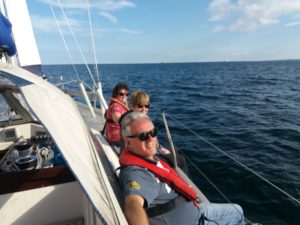 An Easy Life!
An Easy Life!
Sunshine on the decks last August and three of the four taking their RYA Start Yachting two day course were helping level up the boat. Seen here, from L to R; Becky, Linda & David. Despite what it may look like in the image we had some useful Force 6/7 winds and a great two days of sailing. An excellent introduction to this lovely sport.
Own Boat Tuition & Courses
If you have your own boat and would prefer private tuition or an RYA course then these are possible. Your boat would need to be acceptable of course and a daily rate for an instructor would be quoted.
Sailing Today Podcasts
Try these Podcasts Sailing Today Podcasts.
Yacht Skippering
There are times when you might feel that your ‘ticket’ and/or experience will not be adequate for a safe holiday. For the last few years I have enjoyed a commission enabling a larger yacht to be chartered and to sail to more adventurous places.
Reader’s Links
A section featuring links of a maritime interest sent to me.
Steve Austin has uploaded this video of our 2018 Adventure sailing a traditional Dutch flat bottomed boat
Phil Butler highlights the unexpected and rapid shift in Earth’s Magnetic Field.
Peter MacLaren mentioned this article about a Yacht Delivery Skipper’s Life.
Peter Chater has found a remarkable way of plugging a failed seacock – with a carrot! Sea Cock Repair
Peter Chater sent this one about a fisherman suing as a result of a collision Fisherman Sues
Nigel Hierons saw this news item about a flare Flare in recycling explodes
Franek Richardson sent this Time Lapse
Phil Butler mentions the two women rescued after 5 months at sea in the Pacific.
Stuart Porter took and posted this great dolphin display, quite the best I have seen North Sea Dolphins
Try me on Facebook for lots more images Facebook
 Follow me on Instagram@Northumbria Sailing
Follow me on Instagram@Northumbria Sailing
Back editions are now becoming available
For more information contact me via my web page


